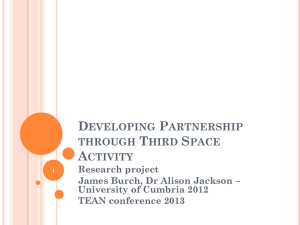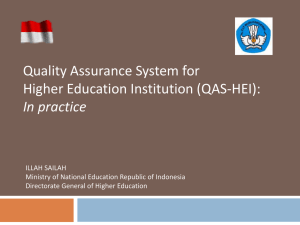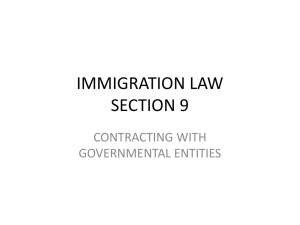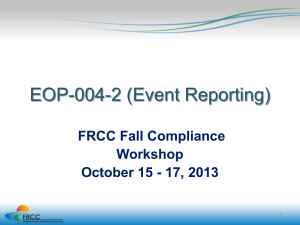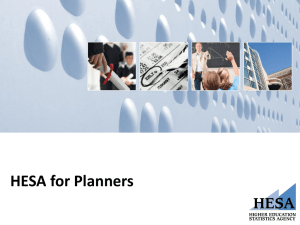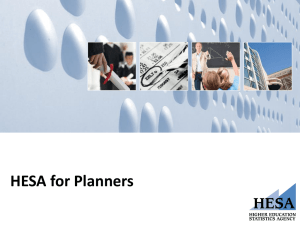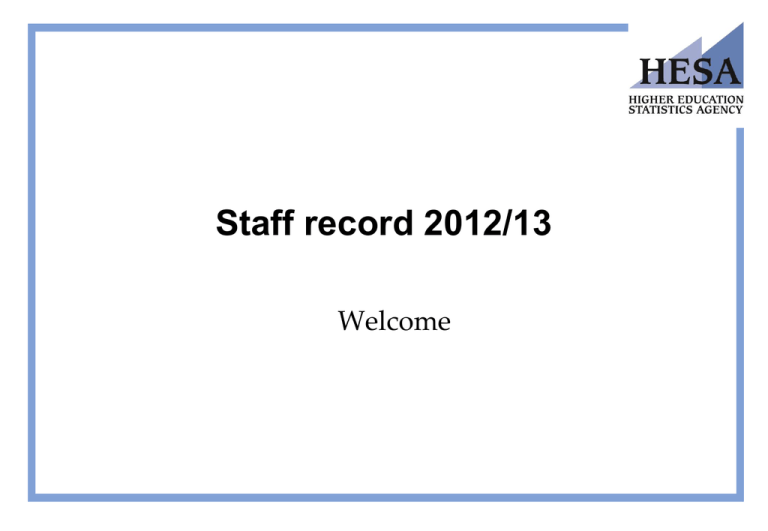
Staff record 2012/13
Welcome
Objectives
• Reflect on the 2010/11 Staff record collection and
identify process improvements for onwards data
collection
• Recognise the reasons behind the changes to the
2012/13 Staff record collection
• Understand the changes to the new file
structure/format and validation
• Learn about the changes to the coverage and fields
C10025 Post-collection analysis
INSERT deadline
160
140
120
100
80
60
40
20
0
2007/08
2008/09
2009/10
2010/11
Commit deadline
160
140
120
100
80
60
40
20
0
2007/08
2008/09
2009/10
2010/11
Sign-off deadline
Remember that sign-off
completes the data
collection process!
Met
deadline
Missed
deadline
Last sign-off not received
until January 2012!
Keep in touch
The Institutional Liaison team are here to help with
all aspects of the data collection process.
If you experience difficulties please get in contact…
liaison@hesa.ac.uk
01242 211144
Data quality checking
No. Commits checked
343
Average wait for queries
2 working days
Maximum wait
5 working days
Average no. transactions checked per
HEI
2
Average no. Minerva queries per HEI
7
Responding to Minerva queries
Of those responses marked as ‘Genuine
oddity’ 13% were missing any explanation
Your responses are used to:
– Explain anomalies in the dataset
– Assist us in understanding trends within
the data
– Help us to analyse our validation
Responding to Minerva queries
• Use of radio buttons
• Mark as draft – remember where using this facility
to send responses to HESA once you have finished.
• Unanswered issues from 2010/11
• Targets for 2011/12
Feedback on new system
features
Checkdoc compare
Exception report retention
Common submission issues
Reporting salaries
• SALREF/SPOINT information now required for all
non-atypical staff
– Hourly paid
• Low salaries
– Picked up by Exception warning where salary less than
£7000
– New validation planned for 2011/12
– When could the FTE salary be legitimately low?
Potential duplicates
• New exception warning to assess individuality of
STAFFID numbers
• For 2010/11 we will be focusing on non-atypicals
only
Staff Record 2012/13
C12025
The Review
• Fundamental review of the Staff record took place
over the last year
• Consultation open from 23 May – 8 July 2011
• 108 responses were received to the consultation
• Analysis of the responses revealed significant
support for most of the proposals for change
Format
Coverage
Fields
Format - XML
What is XML?
• eXtensible Mark-up Language
• Hierarchical data structures in a single file
• International standard for data transfer
• Is used for Student, ITT, Aggregate Offshore, KIS,
DLHE, Staff (12/13) records
Why the change?
Moving with the times
In keeping with data standards
More robust
Allows greater flexibility around the data model
One file - You can validate across the entities
(tables)
In keeping with other HESA record collections
The Data Model
Entity
INSTITUTION
Entity
PERSON
Entity
CONTRACT
Entity
ACTIVITY
Nesting
An Institution
belongs to
C12025
INSTITUTION
A Person
belongs to an
Institution
PERSON
A Contract
belongs to a
Person
CONTRACT
An Activity
belongs to a
Contract
ACTIVITY
Lets look at an example
INSTITUTION
Is an Entity
It describes the reporting
institution
Must occur once and only once
FIELDS
RECID (C12025)
UKPRN
ENTITY
PERSON
INSTITUTION
Is an Entity
Describes the reporting institution
Must occur once and only once
FIELDS
RECID
UKPRN
ENTITY
PERSON
PERSON
Is an Entity
Describes personal characteristics
One per a staff member
FIELDS (examples)
BIRTHDTE
HQHELD
ENTITY
Contract
PREVEMP
What does it look like?
Example
raw XML
data
• Can be edited at source but
should be avoided
• Must follow XML guidelines
• Open and close all tags
• Should appear in this format
<FIELDNAME>value</FIELDNAME>
Please be aware!
• XML means
Bigger files
• Upgrades to IT may be required
• Expect longer processing times
• Update your institution on the changes
• Be prepared
Common problems with XML
Problems with the file structure can result in
error/s
Data fields and/or entities not appearing in the
right order or not at all. Tags not opened/closed
Difficulties with the usability of schema
validation. The terminology provided can be
difficult to interpret
Not encoding using utf-8
Terminology
Terminology
Meaning
Entity
A single entity name groups together a set
of fields which have the same relationship.
Field
A field is an attribute (data item) of an
entity. For the staff record it refers to the
short field name as shown in the coding
manual.
Reason for null
Used to describe a field requiring an
explanation for a null value. It must be
accompanied by a reason code for example.
2: not sought, 3: refused or 9: not applicable.
Terminology
Terminology
Meaning
Parent elements
XML is made up of elements. Entities are
known as the ‘parent elements’.
Child elements
XML is made up of elements. Fields are
known as ‘child elements’ as they belong to
a ‘parent element’ (i.e. entity).
Nested
Elements (fields and entities) can belong to
one another and thus are ‘nested’.
Schema
The schema describes the structure of the
XML document (number of elements,
whether an element can be empty,
default/fixed values, etc.) and valid entries.
The schema is defined by the XSD.
There are many XML training resources on the web, including the W3C
tutorial which can be found at www.w3.org/TR/xmlschema-0
More to come
Validation KIT
Data submission
Coverage
Coverage 2012/13
A significant majority of colleagues responded to the
coverage-related questions and support was given to
the following conclusions to the changes from 12/13
• HESA hopes to be in a position to discontinue
non-academic atypicals
• Move to SOC2010 and 3-digit coding to better
define staff
• Clearer and concise staff definitions
• Data requirement changes to staff categories
What is changing?
<11/12
12/13>
Non academic atypicals may
be removed following support
from you (HEI’s). Awaiting
confirmation from HESA’s
Statutory Customers and the
Equalities and Human Rights
Commission
Additional data requirements
for REF (Research Excellence
Framework) and clinical
academic staff for MSC
(Medical Schools Council)
and DSC (Dentistry School
Council)
Coding of Activities – SOC2010
• From 12/13 the staff record will move from SOC2000 to
SOC2010
• Maintained by The Office of National Statistics
• Reviewed and updated
– Occupational queries
– Key areas within SOC2000 problematic
– Higher proportion of working population classed as
‘Managers’
– Occupational areas developing rapidly
Standard Occupational
Classification codes
Coded at 3-digit level
An index will be
available to help assist
you when coding
Academic employment
function field will be
used to assist with
identifying academic
staff
SOC2010 Major Groups (1-9)
1
Managers
Directors
2
Professional occupations
3
Associate professional
Technical occupations
4
Administrative occupations
Secretarial occupations
5
Skilled trade occupations
6
Caring
Leisure
7
Sales occupations
Customer service
occupations
8
Process operatives
Plant operatives
9
Elementary occupations
Senior officials
Other service
occupations
Machine
operatives
Defining academic atypical staff
Working arrangements not
permanent
• Included in the
reporting period
• Meets one of the
following definition/s
Involve complex
relationships
Atypical
• Contract of
employment and/or
HEI is liable to pay
Class 1 National
Insurance
Contributions
Includes work away from
the supervision of the
normal work provider
Characterised by a high
degree of flexibility
Includes a triangular
relationship that includes
an agent
Are less than four
consecutive weeks
Are for one-off short-term
tasks
Examples
• Stand-by lecturers
• Guest lecturers
• Lecturers teaching
once a year on a
specialist topic
Defining academic staff
• Academic contracts are recorded using academic
employment function and the activity of the contract
is within SOC major groups 1, 2 or 3
• If the staff member’s contract meets with the above
statement, the roles can include
– Managers, Directors, Senior Officials, Professional
occupations, Associate professionals, Technical
occupations, Vice chancellors, Senior academic
managers, Dentists ,Veterinarians and Other
health care professionals
Defining non-academic staff
• The contract/s of employment do not relate to an
academic function irrespective of the categorisation
of their contract activity
• If the staff members contract meets with the above
statement, the roles can include
– Managers, non-academic professionals, student
welfare workers, secretaries, caretakers or cleaners
Defining clinical-academic staff
• Clinical academic contracts are recorded using
academic employment function and the activity of
the contract is within SOC major groups 1, 2 or 3,
and clinical status confirmed by (CLINICAL) being
coded as 1, 2, 3 or 4
• If the staff members contract meets with the above
statement, the roles can include
– Doctors, Nurses, Dentists, Midwives, Health
professionals, and Other clinical academic staff
Data Requirements
Data requirements aid
• Available from www.hesa.ac.uk/C12025/staff_types
• Helps pin-point varying data field requirements by staff category
• Should be used in conjunction with supporting information on HESA web
Institution
1. Is an Entity
2. Describes the reporting institution
3. Provides a home for HEI attributes
4. Has 3 elements including the ‘Person Entity’
Institution
• Presently
– You return INSTID and
RECID for all the three
tables
• Person
– RECID and INSTID
• Contract
– RECID and INSTID
• Grade
– RECID and INSTID
• For 2012/13
– The ‘Institution’
becomes a separate
entity and the following
fields are sent once and
only once and apply to
all staff
– UKPRN
• Replacement for INSTID
– RECID
• C12025
Institution.UKPRN
• Records the UK Provider Reference Number
• A unique identifier allocate to HEI’s by UKRLP (UK
Register of Learning Providers)
• Applicable to all HEI’s and is an 8 digit number
• Will be needed to identify the source of the record
• Used by us and our Statutory Customers
• Find yours at www.ukrlp.co.uk
• Please note the HESA INSTID will continue to be used e.g.
Aardvark
Person
1. Is an Entity
2. Identifies staff registered at the HEI
3. Describes personal characteristics & qualifications
4. Has 28 elements including the ‘Contract Entity’
Changes to existing fields
•
RECID
INSTITUTION
•
HQHELD
•
INSTID
INSTITUTION
•
ACCDIS1
ACCDIS
•
STAFFID
•
ACCDIS2
ACCDIS
•
BIRTHDTE
•
REGBODY
•
GENDER
SEX
•
ABLWELSH
•
NATION
•
DATELEFT
•
ETHNIC
•
LEDEST
•
NATID
NATIOND
•
NATID2
NATIOND
LOCLEAVE
ACTLEAVE
RESCON
•
DISABLED
DISCONTINUED
•
RESACT
DISCONTINUED
•
DATEFHEI
•
UOA
REFUOA2014
•
PREVEMP
•
TOTSAL
DISCONTINUED
•
PREVHEI
•
DISABLE 1
DISABLE
•
DISABLE2
DISABLE
Changes to existing fields
•
RECID
INSTITUTION
•
HQHELD
•
INSTID
INSTITUTION
•
ACCDIS1
ACCDIS
•
STAFFID
•
ACCDIS2
ACCDIS
•
BIRTHDTE
•
GENDER
•
NATION
•
ETHNIC
•
NATID
•
NATID2
•
DISABLED
•
DATEFHEI
•
PREVEMP
•
PREVHEI
• REGBODY
14 (12 Scotland)
SEX
• ABLWELSH
FIELDS REMOVED
• DATELEFT
• LEDEST
OR
REPLACED
NATIOND
FROM 2012/13
NATIOND
• RESACT
DISCONTINUED
LOCLEAVE
ACTLEAVE
RESCON
DISCONTINUED
•
UOA
REFUOA2014
•
TOTSAL
DISCONTINUED
•
DISABLE 1
DISABLE
•
DISABLE2
DISABLE
Additional fields
•
STAFFID
•
ACTCHQUAL
•
OWNSTAFFID
•
BIRTHDTE
•
ACTLEAVE
•
PARLEAVE
•
NATION
•
CLINARD
•
REFUOA2014
•
ETHNIC
•
CURACCDIS
•
REGBODY
•
DATEFHEI
•
DISABLE
•
RELBLF
•
PREVEMP
•
ECRSTAT
•
RESAST
•
PREVHEI
•
GENDERID
•
SEX
•
HQHELD
•
LOCLEAVE
•
SEXORT
•
REGBODY
•
NATIOND
•
CONTRACT
•
ABLWELSH
•
DATELEFT
Additional fields
•
STAFFID
•
ACTCHQUAL
•
OWNSTAFFID
•
BIRTHDTE
•
ACTLEAVE
•
PARLEAVE
•
NATION
•
REFUOA2014
•
ETHNIC
•
REGBODY
•
DATEFHEI
•
RELBLF
•
PREVEMP
•
RESAST
•
PREVHEI
•
SEX
•
HQHELD
•
SEXORT
•
REGBODY
•
CONTRACT
•
ABLWELSH
•
DATELEFT
• CLINARD
18 (17 Scotland)
• CURACCDIS
NEW• OR
DISABLE
• ECRSTAT
REPLACEMENT
• GENDERID
FIELDS•FROM
LOCLEAVE
• NATIOND
2012/13
Person field Coverage
Academic
atypicals
SOC2010 4-9
SOC2010 1-3
Academic staff
Clinical academic staff
12
BIRTHDATE- DISABLEETHNIC-GENDERIDNATIOND-NATIONDOWNSTAFFIDPARLEAVERELBLFSEXSEXORT-STAFFID
13
BIRTHDTE-DATELEFT-DISABLEETHNIC-GENDERID-NATIONDNATION-OWNSTAFFIDPARLEAVE-RELBF-SEX-SEXORTSTAFFID
19
ACTLEAVE-BIRTHDTE-DATEFHEI-DATELEFTDISABLE-ETHNIC-GENDERID-HQHELD-LOCLEAVENATIOND-NATION-OWNSTAFFID-PARLEAVEPREVEMP-PREVHEI-RELBLF-SEX-SEXORT-STAFFID
25
27
ABLWELSH-ACTQUAL-ACTLEAVE-BIRTHDTE-CURACCDISDATEFHEI-DATELEFT-DISABLE-ECRSTAT-ETHNIC-GENDERIDHQHELD-LOCLEAVE-NATIOND-NATION-OWNSTAFFID-PARLEAVEPREVEMP-PREVHEI-REFUOA2013-RELBLF-RESAST-SEX-SEXORTSTAFFID
ABLWELSH-ACTQUAL-ACTLEAVE-BIRTHDTE-CLINARD-CURACCDIS-DATEFHEIDATELEFT-DISABLE-ECRSTAT-ETHNIC-GENDERID-HQHELD-LOCLEAVE-NATIONDNATION-OWNSTAFFID-PARLEAVE-PREVEMP-PREVHEI-REFUOA2013-REGBODYRELBLF-RESAST-SEX-SEXORT-STAFFID
Person field Coverage
Academic
atypicals
SOC2010 4-9
SOC2010 1-3
Legislative
12
13
BIRTHDTE-DATELEFT-DISABLEETHNIC-GENDERID-NATIONDNATION-OWNSTAFFIDPARLEAVE-RELBF-SEX-SEXORTSTAFFID
19
ACTLEAVE-BIRTHDTE-DATEFHEI-DATELEFTDISABLE-ETHNIC-GENDERID-HQHELD-LOCLEAVENATIOND-NATION-OWNSTAFFID-PARLEAVEPREVEMP-PREVHEI-RELBLF-SEX-SEXORT-STAFFID
Planning and
Monitoring
Career monitoring
Academic staff
BIRTHDATE- DISABLEETHNIC-GENDERIDNATIOND-NATIONDOWNSTAFFIDPARLEAVERELBLFSEXSEXORT-STAFFID
25
ABLWELSH-ACTQUAL-ACTLEAVE-BIRTHDTE-CURACCDISDATEFHEI-DATELEFT-DISABLE-ECRSTAT-ETHNIC-GENDERIDHQHELD-LOCLEAVE-NATIOND-NATION-OWNSTAFFID-PARLEAVEPREVEMP-PREVHEI-REFUOA2013-RELBLF-RESAST-SEX-SEXORTSTAFFID
MSC/DSC requirement
Clinical academic staff
27
ABLWELSH-ACTQUAL-ACTLEAVE-BIRTHDTE-CLINARD-CURACCDIS-DATEFHEIDATELEFT-DISABLE-ECRSTAT-ETHNIC-GENDERID-HQHELD-LOCLEAVE-NATIONDNATION-OWNSTAFFID-PARLEAVE-PREVEMP-PREVHEI-REFUOA2013-REGBODYRELBLF-RESAST-SEX-SEXORT-STAFFID
Person.OWNSTAFFID
• Records the HEI’s own internal identifier for staff
• Optional to all HEI’s and staff
• Different from Person.STAFFID
• Up to 20 characters of your own choosing
• We will use this to assist you when quality
checking your data e.g. validation reports
Person.BIRTHDTE
• Records the date of birth of staff
• YYYY-MM-DD format
• Compulsory for all HEI’s and staff
• Default code no longer available
• Used to enable age profiling analysis of staff in HE
• Provides additional information for linking
between records
Equality-related Issues
• HESA have worked with the Equality Challenge
Unit (ECU) to specify a range of changes to the
Staff record 2012/13
• Takes into account new legislative requirements
and the recent Census
• New data requirements introduced to capture data
relating to various new protected characteristics
• (Currently) optional to all staff at all HEI’s
Equality-related Issues
• A good practice guide for HEI’s about monitoring
for equality and diversity can be found at
www.hefce.ac.uk/pubs/hefce/2004/04_14
• Offers various approaches to data collection and
data analysis
• Aims to maximise the volume and quality of data
returns within HEI’s
Person.RELBLF
• Records the religious belief of the member of staff
• Optional for all staff at all HEI’s
• Suggested questions are those used in the 2011
census – available from the field list guidance notes
• The phrase 'Prefer not to say' can be used when
collecting the data
• Will be used to monitor equal opportunities in HE
and will support you meeting obligations to
equality legislation
Person.SEX
• Records the legal sex of the member of staff
• Compulsory for all staff at HEI’s in England,
Northern Ireland and Wales
• Will be used to monitor equal opportunities in HE
and will support you meeting obligations to
equality legislation
• Resurveying of staff should not be required as
guidance for GENDER and SEX are consistent
• Indeterminate code not available
Person.GENDERID
• Records the gender identity of the member of staff
• Based on their own self assessment
• Optional to all HEI’s and staff
• Will be used to monitor equal opportunities in HE
and will support you meeting obligations to
equality legislation
• Suggestion ‘Is your gender identity the same as the
gender you were originally assigned at birth?’
Person.SEXORT
• Records the sexual orientation of the member of
staff
• Based on their own self assessment
• Optional to all HEI’s and staff
• Will be used to monitor equal opportunities in HE
and will support you meeting obligations to
equality legislation
• Suggestion ‘What is your sexual orientation?’
Person.ETHNIC
• Records the ethnicity of the member of staff
• Based on their own self assessment
• Compulsory to all HEI’s and staff
• Will be used to monitor equal opportunities in HE
and will support you meeting obligations to
equality legislation
• Due to changes in the census categories, previous
codes '11 White - British' or '12 White - Irish' are no
longer valid
Person.ETHNIC
• Expected that current staff members are recoded,
where applicable, using the new coding frame
• Staff at institutions in England, Wales and
Northern Ireland previously returned as '11 White
- British' or '12 White - Irish' should now be
returned as '10 White‘
• Staff at institutions in Scotland previously returned
as '11 White - British' or '12 White - Irish' should
now be returned as '19 Other White background'
Person.DISABLE
• Records the disability of a member of staff
• Based on their own self assessment
• Compulsory for all HEI’s and staff
• DISABLE 1 (024) and 2 (025) will be removed
• DISABLED (010) will be removed
• Best practice to resurvey staff as ‘unknown’ code
no longer available
Person.DISABLE
• Will be used to monitor equal opportunities in HE
and will support you meeting obligations to
equality legislation
• 00 ‘No known disability’ should only be returned
when a member of staff indicates that they do not
have a disability
Person.NATIOND
• Records the national identity of staff
• Compulsory for all staff at HEI’s in Wales
• No longer Person.NATIOND 1 and 2
• Can code up to two separate entries
• Used to monitor the impact of policies and
practices on staff of a UK background and compare
HE sector data with that from other areas of the
economy
Person.PARLEAVE
• Identifies whether any parental leave was taken by
staff during the reporting year
• (1) Maternity leave (2) Additional paternity leave
or (3) Adoption leave
• Optional to all HEI’s and staff
• Will be used to monitor equal opportunities in HE
and will support you meeting obligations to
equality legislation
Leaving Information
• The data currently being collected about end of
contracts and leaving destinations has become
untidy, for example reason for leaving and activity
after leaving were in the same field
• New fields have been added to both the Contract
and Person entities to collect new retrospective
information
• Clearer definitions and better coding options
Person.ACTLEAVE
• Records the activity of staff after leaving
employment at the reporting HEI
• Compulsory for all SOC2010 Major Groups 1, 2 or 3
staff (as defined by Activity.ACTSOC) at all HEI’s
• Associated fields must be returned also i.e.
Person.DATELEFT is not null and Contract.RESCON
is not death
• Will be used to monitor the activity of staff after
leaving HEI
Person.LOCLEAVE
• Records the location of staff after leaving
employment at the reporting HEI
• Compulsory for all SOC2010 Major Groups 1, 2 or 3
staff (as defined by Activity.ACTSOC) at all HEI’s
• Associated fields must be returned i.e.
Person.DATELEFT must exist and
Contract.RESCON is not death
• Will be used to monitor the location of staff after
leaving employment
Person.DATEFHEI
• Records the date on which staff started their
current period of continuous service with the
reporting HEI (format YYYY-MM-DD)
• Compulsory for all non-atypical staff (as defined
by Contract.TERMS) at all HEI’s
• Will be used to track career histories of staff for
employment research and profiling
Person.DATEFHEI
• This field must be updated when a break in
continuous service occurs (regardless of length)
and in this circumstance it is imperative that
Person.STAFFID is retained in order to facilitate
tracking
• Reason for null can be returned in exceptional
circumstances;
<DATEFHEI ReasonForNull=“1”></DATEFHEI>
Person.REFUOA2014
• Records the Research Excellence Framework (REF) unit of
assessment for staff
• Compulsory for all academic research or teaching and research
staff (as defined by Contract.ACEMPFUN) at all HEI’s
• Used to support the REF
• Any queries on this field should be addressed to info@ref.ac.uk
• Units of Assessment and recruitment expert panels can be found
at;
http://www.hefce.ac.uk/research/ref/pubs/2010/01_10/01_10.pdf
Person.REFUOA2014
• The first two characters refer to the unit of
assessment; Example (01) Clinical Medicine
• The final character is the letter which indicates if it
was single or multiple submission
• ‘Z’ must be used for single submissions
• If more than one, valid entry patterns are 01-36
followed by letters A, B, C etc.
• Please note this field is not required for 2012/13
Person.ECRSTAT
• Records the early career researcher status of staff
• Compulsory for all academic research or teaching and
research staff (defined by Contract.ACEMPFUN) at all
HEI’s
• This field should be completed for staff in post in
2012/13 with reference to REF definitions and census
date
• Any queries should be directed to info@ref.ac.uk
• Will be used to support the Research Excellence
Framework (REF)
Person.RESAST
• Records whether or not the member of staff was a
research assistant
• Compulsory for all academic research or teaching
and research staff (defined by
Contract.ACEMPFUN) at all HEI’s
• Used to support the Research Excellence
Framework (REF)
• Any queries on this field should be addressed to
info@ref.ac.uk
Clinical Academics
• Following discussions with the Medical Schools
Council (MSC) and Dentistry Schools Council
(DSC) additional data will be required
• MSC/DSC separate data collection will be
discontinued in 2013/14 therefore reducing the data
burden on HEI’s
• Coding frames have been updated as appropriate
Person.CLINARD
• Identifies staff that hold Clinical
Excellence/Merit/Distinction awards
• Compulsory for all clinical academic doctors and
dentists (defined by Contract.CLINICAL) at all HEI’s
• Whilst we are aware of two award systems running
concurrently in England, an individual can only hold
one award
• Will be used to monitor the number of staff working
in HEI’s with these type of awards
Person.REGBODY
• Records the regulatory body for staff working in
health and social care professions regulated by a
statutory health or social care regulatory body
• Compulsory for all clinical status contracts
(defined by Contract.CLINICAL) at all HEI’s
• Optional for staff at all HEI’s who, although
registered to practise with a statutory health and
social care regulatory body, do not hold a clinical
contract
Person.REGBODY
• Used to identify the appropriate regulatory body
for staff registered to practice in medical, health
and social care professions
• Note; Staff previously coded to (08) General Social
Care Council should now be coded to (07) Health
Professions Council (HPC)
Academic Information
• Reference made in the White paper detailing a requirement
for data on teaching qualifications on academics
“We encourage higher education institutions to publish
anonymised information for prospective and existing students
about the teaching qualifications, fellowships and expertise of
their teaching staff at all levels.”
• HESA has worked with the Higher Education Academy
(HEA) to create a coding frame
• Academic subject area data changes based on results of
proposal/s
Person.ACTCHQUAL
• Records whether or not academic staff hold Higher
Education teaching qualifications
• Compulsory for all academic teaching or teaching and
research staff (defined by Contract.ACEMPFUN) at
HEI’s in England, Northern Ireland or Wales
• Optional for HEI’s in Scotland
Person.ACTCHQUAL
• Can code up to 6 different entries
• However, it is expected for an individual only one
of the Higher Education Academy (HEA) codes 02,
03, 04 & 05 will apply at a given point of time
• Will be used to monitor the number of staff in
HEI’s with a relevant HE teaching qualification
and what that qualification/s is
Person.CURACCDIS
• Records the Joint Academic Coding System (JACS
3.0) code for the academic discipline currently
being taught and/or researched by the member of
staff
• Compulsory for all non atypical (Contract.TERMS)
academic teaching and/or research staff
(Contract.ACEMPFUN) at all HEI’s
• Should only be updated for staff who have
undertaken a major shift in their academic activity
Person.CURACCDIS
• It is expected that HEI’s make use of the new
4-digit coding frame available
• Where a member of staff works in two subjects
then a second field should be used
• If a member of staff works in three or more subjects
please use the two which best reflect the discipline
• Will be used to identify the academic disciplines of
staff
Understanding Careers
• To be able to better understand careers, specifically
academic, it is necessary to track staff year on year
• Person.STAFFID makes this possible if the staff
member remains at one HEI.
• If a member of staff transfers to another HEI the
Person.STAFFID does not always remain with them
• Whilst there has been improvement in this area,
there are still some significant gaps, thus limiting the
analysis that can be done with the data
Understand Careers
• Proposals were made to include staff names, full or
partial National Insurance Numbers
• This proposal has been temporarily suspended and
will not be collected in 2012/13
• May be added from 2013/14 – update will follow
• Other options will be explored during this time
Contract entity
Contract.LEVELS – Contract
levels
• Replaces the Grade table
• Coding frame allows monitoring of grades/levels
within HE sector
• UCEA senior staff and XpertHR salary surveys
• Guidance on code allocation provided
Contract.CLINSUB – Clinical subspecialty
• Part of HESA’s agenda to reduce burden
• Replaces MSC and DSC surveys of staffing levels
• Detailed coding frame including 101 specialties
• Need to liaise with departmental colleagues
MSC 2010
DSC 2010
37 HEIs
19 HEIs
CLINSUB – Clinical sub-speciality
• Only required for contracts with CLINICAL coded
as 01 ‘Clinical academic doctors and dentists’
• Coding frames for HSPEC and CLINSUB align
• Sensible coding tie ups expected
HSPEC
CLINSUB
04 Paediatrics & Child Health
0401 Paediatrics
0402 Paediatric neurology
0403 Paediatric cardiology
0404 Neonatology
Contract.RESCON – Reason for
end of contract
• Part of the trio replacing LEDEST
• Information captured by HR
• Coverage = all contracts where Contract.ENDCON
is not null
• Continued employment code where staff changing
contract and not leaving HEI
Valid entries
1
Continued employment, new HESA contract record generated
2
Atypical contract issued
3
End of fixed-term contract
4
Voluntary redundancy
5
Other redundancy
6
Resignation
7
Retirement (excluding ill-health)
8
Death
9
Other (includes dismissal and ill-health)
Contract.MOEMP – Mode of
employment
• This is not a new field!
• However…there is a new code…
6 Dormant
• HEI requested code to allow zero hours contracts
to be returned
• Cross-validation will make a 0FTE and 0Salary
acceptable for these contracts
Contract.OWNCONTID – Own
contract identifier
• Optional field
• Facilitate ease of tracking and data checking
• To be listed within all applicable HESA reports:
validation, exception, muster, data supply
Activity entity
Activity entity
• Nested within the contract entity
• Replaces the old ACT1/2/3, CCENTRE1/2/3 and
CCPROP1/2/3 fields
• Entity can be repeated up to 3 times per contract
<Activity>
<ACTSOC>
<CCENTRE>
<CCPROP>
</Activity>
Activity.ACTSOC – Activity Standard
Occupational Classification
• SOC coding frame moving to SOC2010
• Reason for change: Bring framework up-to-date.
Increased detail offer by SOC2010
• Be aware that SOC2000 does not map directly to
SOC2010 – activities will need to be recoded. Index
being created by IER
SOC2010
Coding frame splits out activities to a more detailed
level than SOC2000.
However….
It does NOT provide detail on academic/nonacademic activity
Academic activity detailed through ACEMPFUN
field
Contract.ACEMPFUN –
Academic employment function
• This field sits within the CONTRACT entity
• Required for all SOC2010 Major Groups 1-3
• ACEMPFUN is used in conjunction with
ACTSOC to identify academic contracts
Activity.CCENTRE – Cost
centre
New coding frame for 2012/13 across HESA data
streams
Need to liaise with colleagues
involved in compiling the
Student and Finance returns
CCENTRE changes
Reasons for change:
– Align with REF2014 UoAs
– Move to 3 digit coding frame to distinguish from UoAs
– Make coding frame more flexible for future changes
Further details on cost centre changes:
http://www.hesa.ac.uk/content/view/2128/687/
CCENTRE changes
Removed
29 Social studies
31 Humanities & Language based
studies
33 Design & creative arts
Added
125 Area studies
127 Anthropology & developmental
studies
128 Politics & international studies
129 Economics & econometrics
130 Law
131 Social work & social policy
132 Sociology
138 English language & literature
139 History
140 Classics
141 Philosophy
142 Theology & religious studies
143 Art & design
144 Music, dance, drama & performing
arts
Cost Centre data collection
• HESA will collect as contextual data each institution's
allocation of departments to (revised) Cost Centres
• The provision of this information to HESA will be
compulsory in England and optional for institutions in
Wales, Scotland and Northern Ireland
• The data will be collected via campus record collection in
June 2013
• The allocation of professional services to Non-academic
Cost Centres (Professional Services Cost Centres from
2012/13) will not be mapped and returned to HESA
Validation
Insert-stage
XML splits validation rules into 2 types of check:
– Schema: ‘well formedness’
• Conformity to the .XSD
• Missing fields
• Tagging
• Invalid codes
– Business: logic of the submission
• Coverage
• Consistency between fields
• Consistency between entities
Schema
Business
Pass
INSERT
Validation kit
• User friendly interface
• One kit framework for all HESA XML data
collections
• Framework connects to web to download latest
rule versions
*We recommend that the kit is downloaded onto
each PC rather than onto a local network*
Validation kit
• Business rule switches can be applied to focus data
checking
• Details of errors/warnings triggered can be
downloaded to Excel & printed
• Configuration tab – can set to local preferences
www.hesa.ac.uk/validation_help
Configuring the validation kit
• Recommended minimum specification of a Dual
core processor and 2 GB RAM
• Kit validates in batches
• Can change size of batch to alter processing times:
Reduce size = less memory but greater processing times
Increase size = less processing times but greater memory
Schema validation
Business rule validation
Business rule validation
Validation kit
First release of C12025 kit
(schema level checks)
Spring 2012
Second release of C12025 kit
(including business rules)
Autumn 2012
Field list and
detail
Includes:
•
Entity descriptions
•
Field descriptions
•
Business rule validation
(coming soon…)
•
Change management notes
Features:
•
Page can be sorted by both
long names and short names.
•
Display can be altered to show
fields relevant by country.
http://www.hesa.ac.uk/C12025
Pre-XML
------------------------------------------------------------------------------------XML
Or
Data submission
• Submission process remains virtually identical
• Changes:
– File type XML
– Combined file
Multiple files can be submitted but…
Each file needs to be complete and discreet
Where a staff member appears in both files need to ensure
personal characteristics consistent
Editing data
Recommend that as far as possible all edits are done
through software system…..
However if you do need to edit the raw XML then…
– Be aware that the files can be quite large
– Use an editing package e.g. UltraEdit, XML Notepad to
view/edit files
Institutional Liaison survey 2011
• Survey ran in December 2011 to review customer
satisfaction on the services provided by the IL
team.
• 288 responses received: 30% were Staff contacts
• Survey questions looked at the email and
telephone helpdesk as well as online guidance
documentation.
• Results will be used to further the customer
experience
Institutional Liaison survey 2011
Liaison@hesa.ac.uk email response times
Same day
Next day
Longer
Institutional Liaison survey 2011
01242 211144 pick up speeds
Within 4 rings
Within 8 rings
Longer
Further help and support
01242 211144
liaison@hesa.ac.uk
01242 211472
training@hesa.ac.uk

